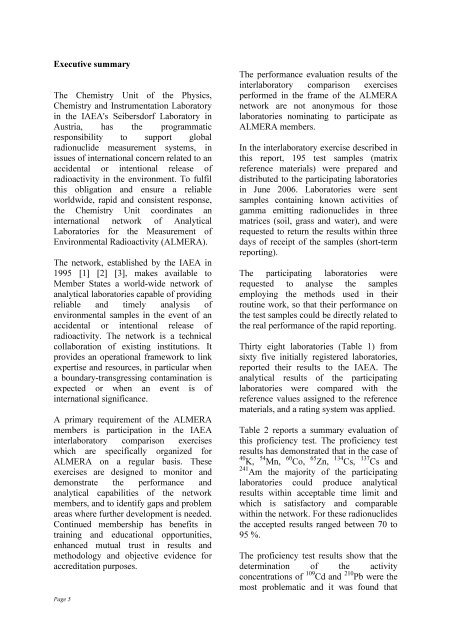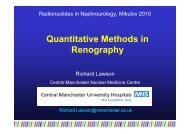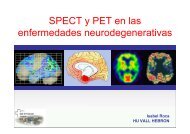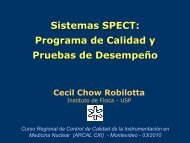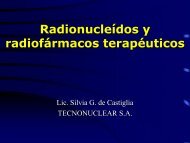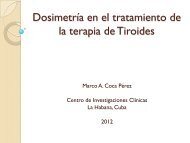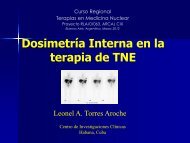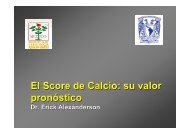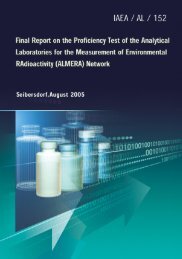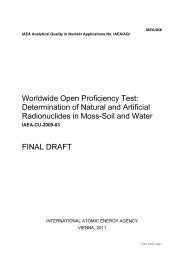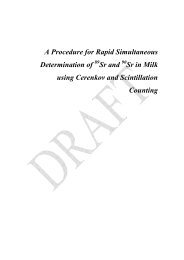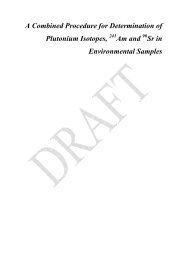Report - NUCLEUS - IAEA
Report - NUCLEUS - IAEA
Report - NUCLEUS - IAEA
Create successful ePaper yourself
Turn your PDF publications into a flip-book with our unique Google optimized e-Paper software.
Executive summary<br />
The Chemistry Unit of the Physics,<br />
Chemistry and Instrumentation Laboratory<br />
in the <strong>IAEA</strong>'s Seibersdorf Laboratory in<br />
Austria, has the programmatic<br />
responsibility to support global<br />
radionuclide measurement systems, in<br />
issues of international concern related to an<br />
accidental or intentional release of<br />
radioactivity in the environment. To fulfil<br />
this obligation and ensure a reliable<br />
worldwide, rapid and consistent response,<br />
the Chemistry Unit coordinates an<br />
international network of Analytical<br />
Laboratories for the Measurement of<br />
Environmental Radioactivity (ALMERA).<br />
The network, established by the <strong>IAEA</strong> in<br />
1995 [1] [2] [3], makes available to<br />
Member States a world-wide network of<br />
analytical laboratories capable of providing<br />
reliable and timely analysis of<br />
environmental samples in the event of an<br />
accidental or intentional release of<br />
radioactivity. The network is a technical<br />
collaboration of existing institutions. It<br />
provides an operational framework to link<br />
expertise and resources, in particular when<br />
a boundary-transgressing contamination is<br />
expected or when an event is of<br />
international significance.<br />
A primary requirement of the ALMERA<br />
members is participation in the <strong>IAEA</strong><br />
interlaboratory comparison exercises<br />
which are specifically organized for<br />
ALMERA on a regular basis. These<br />
exercises are designed to monitor and<br />
demonstrate the performance and<br />
analytical capabilities of the network<br />
members, and to identify gaps and problem<br />
areas where further development is needed.<br />
Continued membership has benefits in<br />
training and educational opportunities,<br />
enhanced mutual trust in results and<br />
methodology and objective evidence for<br />
accreditation purposes.<br />
Page 5<br />
The performance evaluation results of the<br />
interlaboratory comparison exercises<br />
performed in the frame of the ALMERA<br />
network are not anonymous for those<br />
laboratories nominating to participate as<br />
ALMERA members.<br />
In the interlaboratory exercise described in<br />
this report, 195 test samples (matrix<br />
reference materials) were prepared and<br />
distributed to the participating laboratories<br />
in June 2006. Laboratories were sent<br />
samples containing known activities of<br />
gamma emitting radionuclides in three<br />
matrices (soil, grass and water), and were<br />
requested to return the results within three<br />
days of receipt of the samples (short-term<br />
reporting).<br />
The participating laboratories were<br />
requested to analyse the samples<br />
employing the methods used in their<br />
routine work, so that their performance on<br />
the test samples could be directly related to<br />
the real performance of the rapid reporting.<br />
Thirty eight laboratories (Table 1) from<br />
sixty five initially registered laboratories,<br />
reported their results to the <strong>IAEA</strong>. The<br />
analytical results of the participating<br />
laboratories were compared with the<br />
reference values assigned to the reference<br />
materials, and a rating system was applied.<br />
Table 2 reports a summary evaluation of<br />
this proficiency test. The proficiency test<br />
results has demonstrated that in the case of<br />
40 K, 54 Mn, 60 Co, 65 Zn, 134 Cs, 137 Cs and<br />
241 Am the majority of the participating<br />
laboratories could produce analytical<br />
results within acceptable time limit and<br />
which is satisfactory and comparable<br />
within the network. For these radionuclides<br />
the accepted results ranged between 70 to<br />
95 %.<br />
The proficiency test results show that the<br />
determination of the activity<br />
concentrations of 109 Cd and 210 Pb were the<br />
most problematic and it was found that


